The Aquitaine region of France is home to many different species of birds. From the majestic eagles that soar above the Pyrenees to the colorful songbirds that flit through the lush countryside, the birds of Aquitaine offer a breathtaking array of avian life.
Whether you are an avid birder or simply wish to observe the beauty of nature, Aquitaine is a great place to explore the wonderful world of birds. From coast to coast, the region is filled with a variety of habitats that support many different species of birds.
From wetlands to forests, the region provides a wealth of opportunities for birding. Whether you are looking for a rare species or just a pleasant morning spent watching birds, Aquitaine has something for everyone.
1. Eurasian Collared Dove
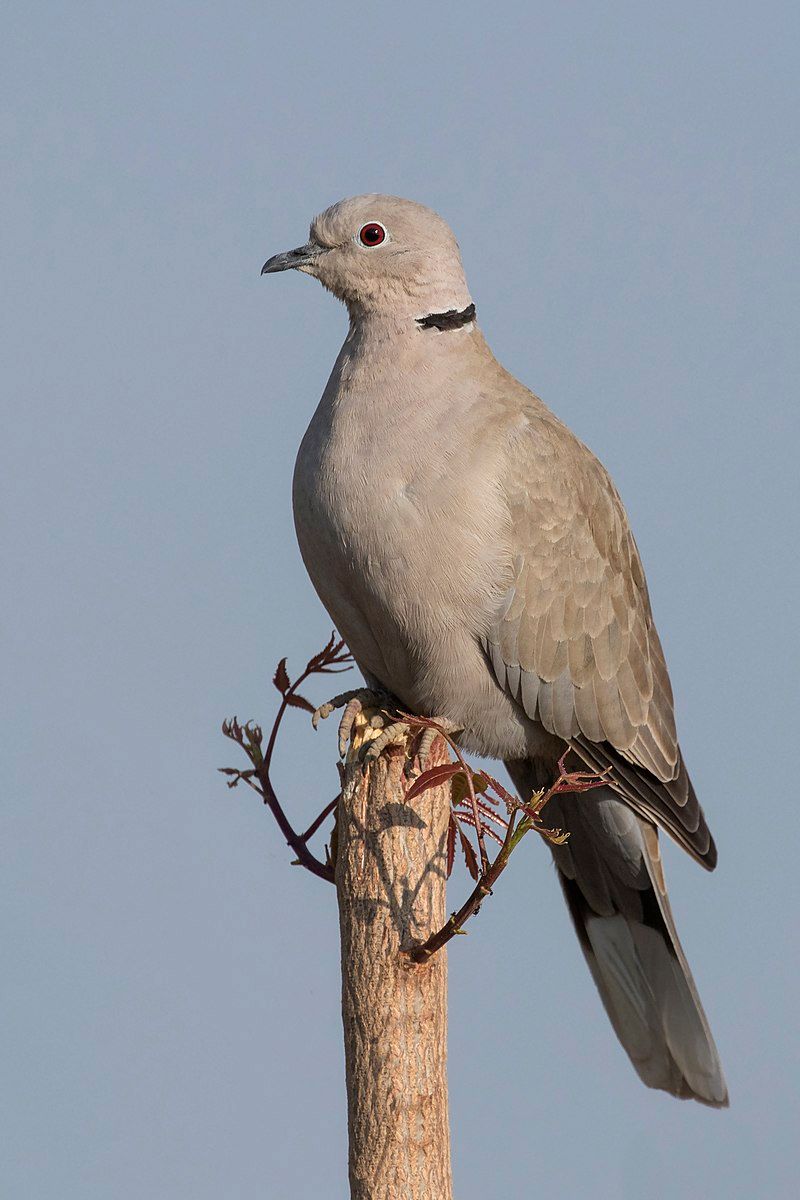
The Eurasian collared dove is a species of dove native to parts of Europe and Asia. It is a relatively small species of dove, with a grey-brown colouring and distinctive black collar. This species has a wide distribution, and can be found in many parts of Europe and Asia.
In recent years, the Eurasian collared dove has been introduced to some other regions, including Japan, North America and islands in the Caribbean.
This is likely due to intentional human introduction of the species, or accidental movements of individuals from one region to another. The Eurasian collared dove has adapted well to its new environments, and has even become a nuisance to some areas.
The species is now considered an invasive species in some regions, due to its ability to quickly establish itself in new areas.
The species has been known to outcompete some native bird species for food and nesting sites, leading to a decrease in the populations of these native species. Despite its potential for causing harm to native bird populations, the Eurasian collared dove is still a popular species with birdwatchers and other wildlife enthusiasts.
The species is known for its distinctive call and its willingness to frequent urban areas, which makes it an easy species to observe in many parts of the world.
| Kingdom | Animalia |
| Phylum | Chordata |
| Class | Aves |
| Order | Columbiformes |
| Family | Columbidae |
| Genus | Streptopelia |
| Species | S. decaocto |
2. Wood Pigeon
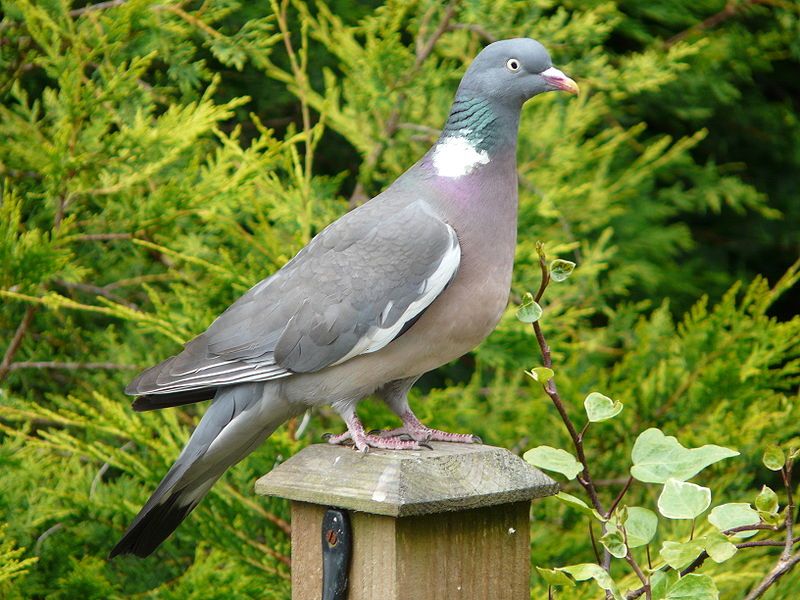
The common wood pigeon is a species of dove and pigeon found in the western Palearctic region. It is one of the largest species of its family and is easily identifiable by its large size and distinctive white patch on its neck and chest.
The wood pigeon is part of the genus Columba, which encompasses several other closely related species such as the rock dove. This genus is characterized by its stout body, short legs, and rounded wings.
Wood pigeons can be found in most urban and rural areas of western Europe, and they are also found in parts of Asia, Africa, and even North America. They are highly adaptable birds, and can often be seen foraging in gardens and parks.
In terms of diet, wood pigeons primarily feed on seeds, berries, and other plant material. They are also known to occasionally prey on smaller birds, eggs, and insects.
| Kingdom | Animalia |
| Phylum | Chordata |
| Class | Aves |
| Order | Columbiformes |
| Family | Columbidae |
| Genus | Columba |
| Species | C. palumbus |
3. Little Bustard
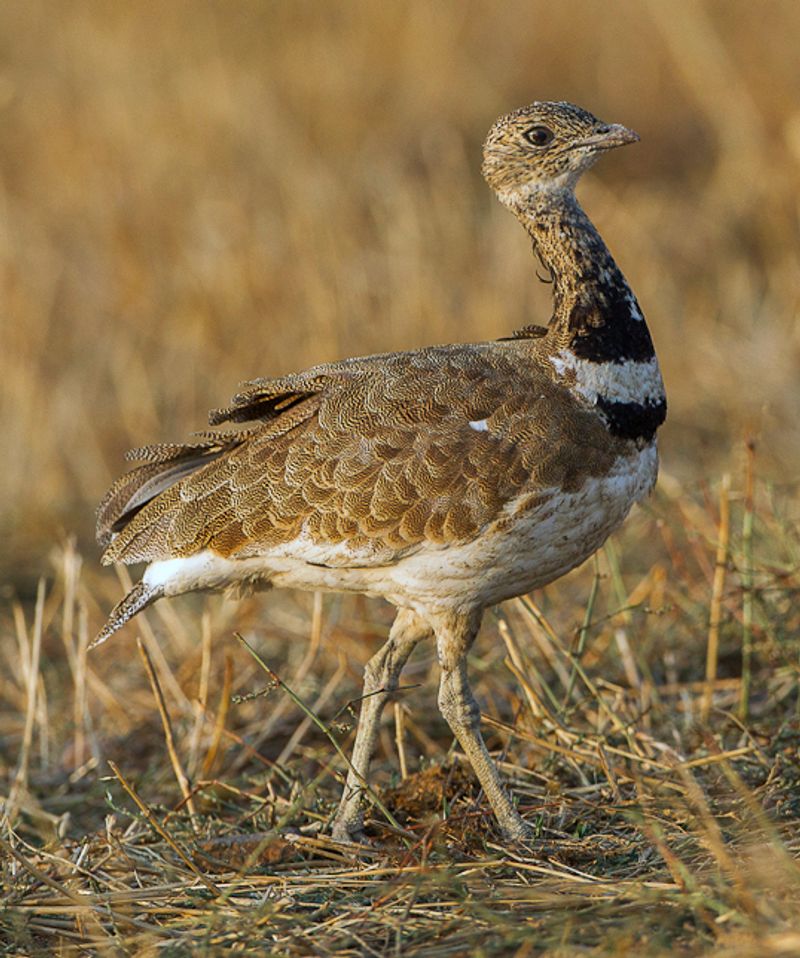
The little bustard is a bird belonging to the bustard family, which is a type of large bird. It is the only species in the genus Tetrax, which is derived from the Ancient Greek word for a type of gamebird.
This gamebird was mentioned by a number of ancient authors, including Aristophanes, and likely refers to the little bustard. The little bustard is a large bird, with a distinctively long neck and legs, and can be found in many parts of Europe, as well as some parts of Asia.
It is known to inhabit open areas, such as grasslands and steppes, and feeds on insects, small mammals, and other small creatures.
Due to agricultural development and hunting, the little bustard is now considered to be a threatened species and is protected in some parts of its range.
| Kingdom | Animalia |
| Phylum | Chordata |
| Class | Aves |
| Order | Otidiformes |
| Family | Otididae |
| Genus | Tetrax |
| Species | T. tetrax |
4. Grey Heron
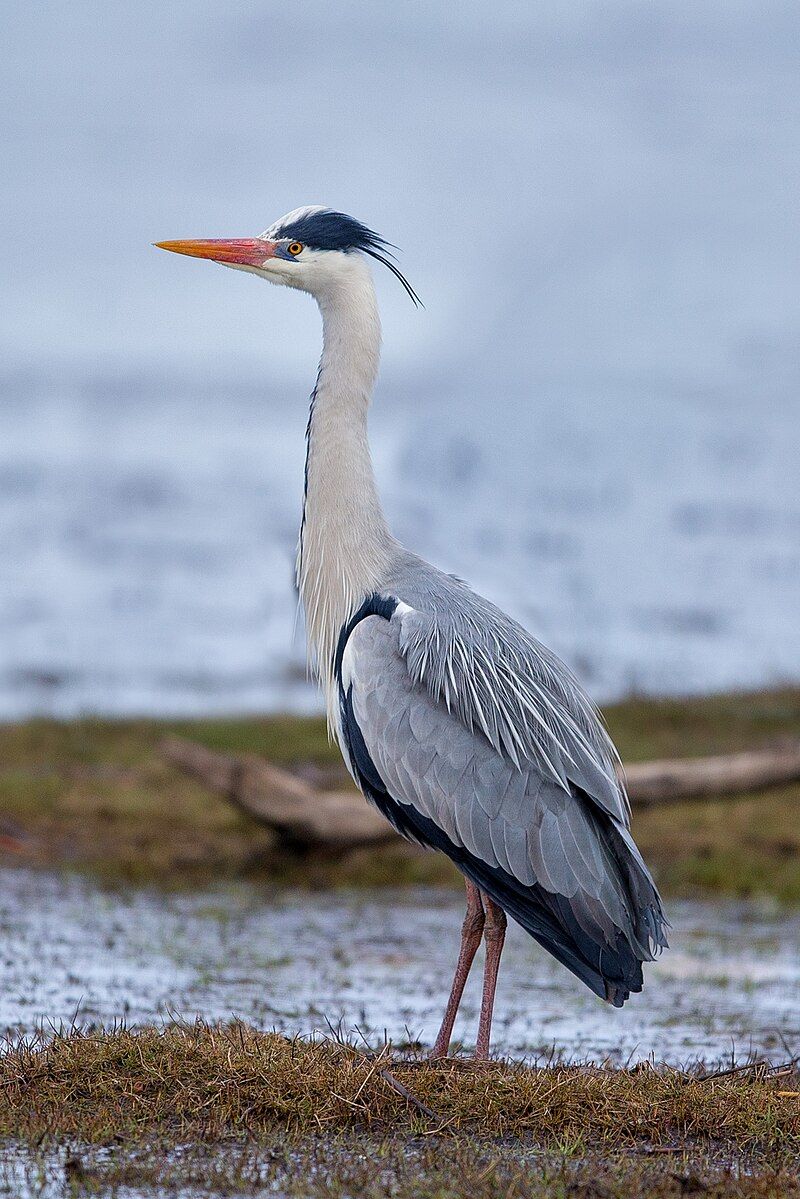
The grey heron is a majestic and graceful bird belonging to the heron family, Ardeidae. It is found in many parts of the world, including temperate Europe, Asia, and parts of Africa.
Generally, these birds are resident in the places where they are found, meaning that they stay in the same area for most of the year. However, in more northern parts of its range, some grey heron populations may migrate southwards during the autumn months.
This helps them to avoid the cold winter temperatures and find a warmer environment. The grey heron is a tall, slender bird, with long legs and a long neck. Its plumage is typically grey, while its head and neck feature a white and black pattern.
Its diet consists mainly of fish, frogs, and small mammals, which it typically catches in shallow water or wetland areas.
It is an interesting sight to see a grey heron patiently waiting in the water for its prey to appear.Grey herons are considered to be a species of least concern by the International Union for Conservation of Nature, meaning that their population is stable.
Nevertheless, their wetland habitats are under threat due to human activities such as pollution and the destruction of natural habitats. Therefore, it is important to protect and preserve these areas so that we can continue to enjoy the beauty of these magnificent birds.
| Kingdom | Animalia |
| Phylum | Chordata |
| Class | Aves |
| Order | Pelecaniformes |
| Family | Ardeidae |
| Genus | Ardea |
| Species | A. cinerea |
5. Mallard
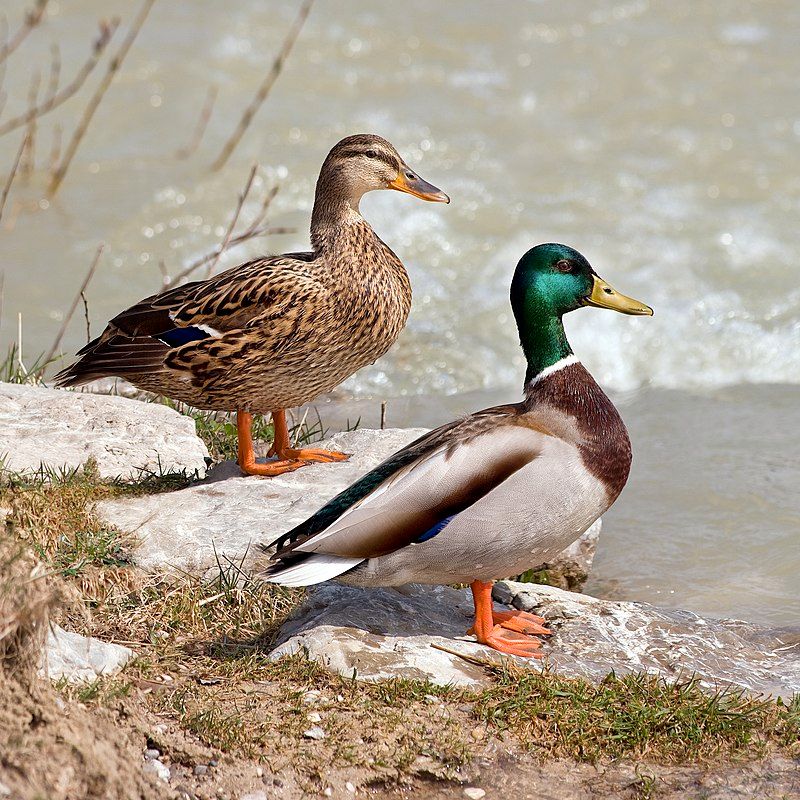
The mallard duck, also known as the wild duck, is a species of duck that inhabits a wide range of climates. It is found in temperate and subtropical areas in the Americas, Eurasia, and North Africa.
The mallard has also been introduced to a number of countries in the Southern Hemisphere, such as New Zealand, Australia, Peru, Brazil, Uruguay, Argentina, Chile, Colombia, the Falkland Islands, and South Africa. The mallard is a dabbling duck, meaning it feeds close to the surface of shallow bodies of water, such as ponds and streams.
It dives only if necessary, and spends much of its time searching for food on the water’s surface. The species is well-adapted to a variety of habitats, from wetlands and rivers to parks and gardens. The mallard is a sociable bird, often seen in large flocks.
It is also a highly successful species, with strong populations in many areas. The mallard is a popular game bird and is widely hunted for sport.
It is also a common sight in cities and towns, where it is often found in public parks and gardens. The mallard is an important food source for a variety of predators, including foxes, raccoons, and hawks.
It is also an important prey species for numerous species of fish, such as bass and pike. The mallard is also an important species for human consumption and is widely hunted for its meat.
It is also used in a number of traditional dishes, such as the popular French dish, the “duck confit”.The mallard is an iconic species, and its presence is an indication of the health of a wetland system.
Its wide range and adaptability make it an important species for conservation efforts, and it is listed as a species of least concern by the IUCN.
| Kingdom | Animalia |
| Phylum | Chordata |
| Class | Aves |
| Order | Anseriformes |
| Family | Anatidae |
| Genus | Anas |
| Species | A. platyrhynchos |
6. Common Crane
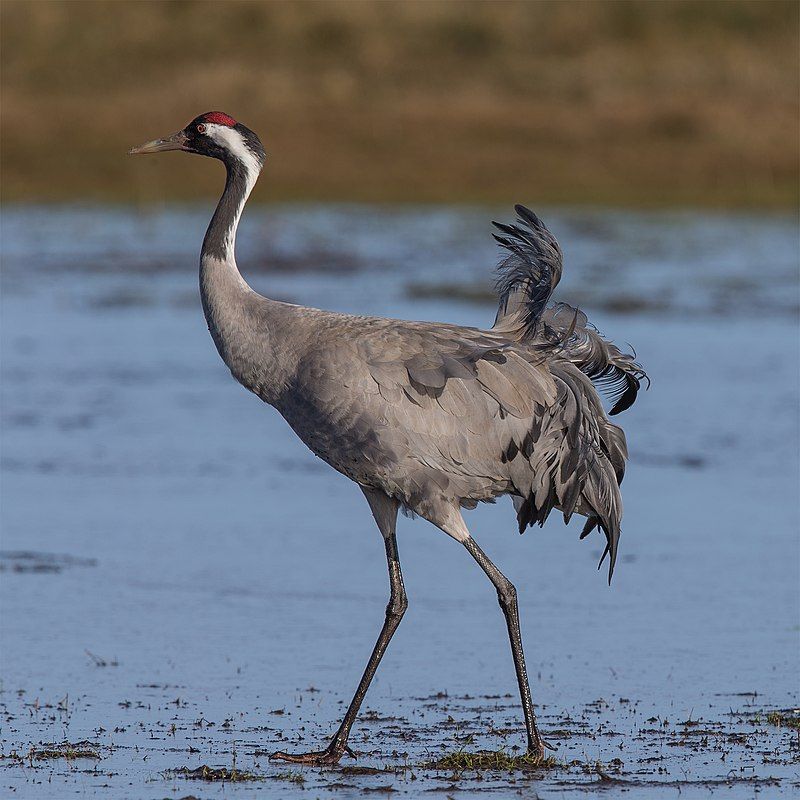
The common crane, also known as the Eurasian crane, is a medium-sized bird found in the family Gruidae, cranes. It is the most abundant species of crane in Europe and is regularly seen in the region.
The only other crane species that can be found in Europe with any amount of regularity is the demoiselle crane and the Siberian crane, both of which are found in the far eastern part of the continent.
The common crane is a beautiful bird with a large wingspan and a distinctive black and white plumage. It is found in a wide variety of habitats, including wetlands, grasslands, and even cultivated fields.
The species is widely distributed across Europe and Asia, and is a common sight in many countries. The common crane is an omnivore, feeding on a variety of plants, insects, and small animals. It also relies heavily on grains and other small seeds for sustenance.
The species is considered to be a long-distance migrant, travelling long distances between its breeding and wintering grounds. Each year, the number of common cranes in Europe increases, as the species is becoming increasingly adapted to the changing environment.
The common crane is an important species for both the environment and for humans. It plays an important role in maintaining the balance of nature, as it helps to keep insect populations in check.
Additionally, it provides food sources for other wildlife, such as other bird species and foxes. For humans, the crane is a symbol of good luck and has been used as a symbol in traditional cultural festivals and ceremonies across Europe.
| Kingdom | Animalia |
| Phylum | Chordata |
| Class | Aves |
| Order | Gruiformes |
| Family | Gruidae |
| Genus | Grus |
| Species | G. grus |
7. Common Moorhen
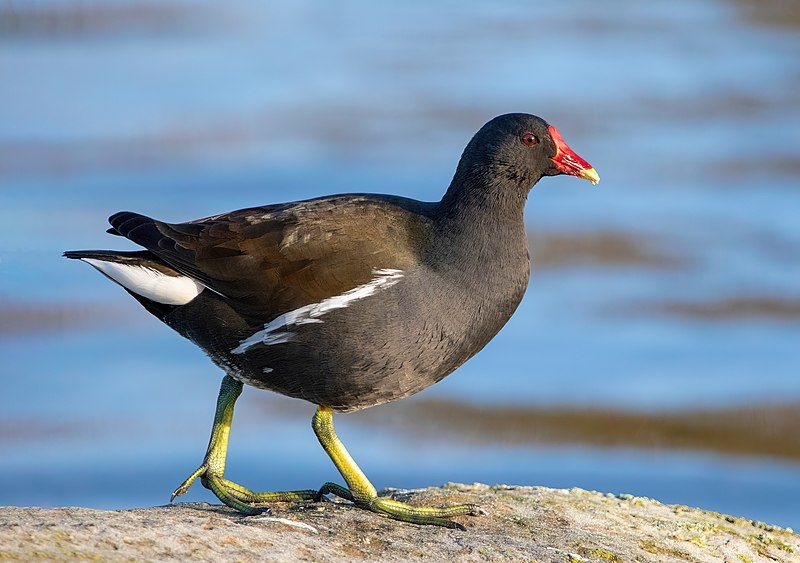
The common moorhen, also known as the waterhen or swamp chicken, is a bird species that belongs to the rail family of birds. It is found in many parts of the Old World, including Europe, Asia, and Africa.
The common moorhen is typically found in areas with plenty of vegetation, such as marshes, ponds, canals, and other wetlands. They are well adapted to living in wet conditions and can be seen swimming as well as walking on land.
They are omnivorous, eating both plant matter and small animals, such as insects and fish. The common moorhen is easily identified by its black body, yellow bill, and red frontal shield. Its legs are bright yellow-green, and its tail is tipped with white.
These birds are quite social, and can often be found in large groups. They are also quite noisy, and their distinctive call can often be heard in the vicinity. The common moorhen is an important species in the wetlands, and it plays a role in the food chain.
It is also an important indicator of healthy wetland ecosystems, as its presence indicates that the water is clean and free of pollutants.
| Kingdom | Animalia |
| Phylum | Chordata |
| Class | Aves |
| Order | Gruiformes |
| Family | Rallidae |
| Genus | Gallinula |
| Species | G. chloropus |
8. Grebes
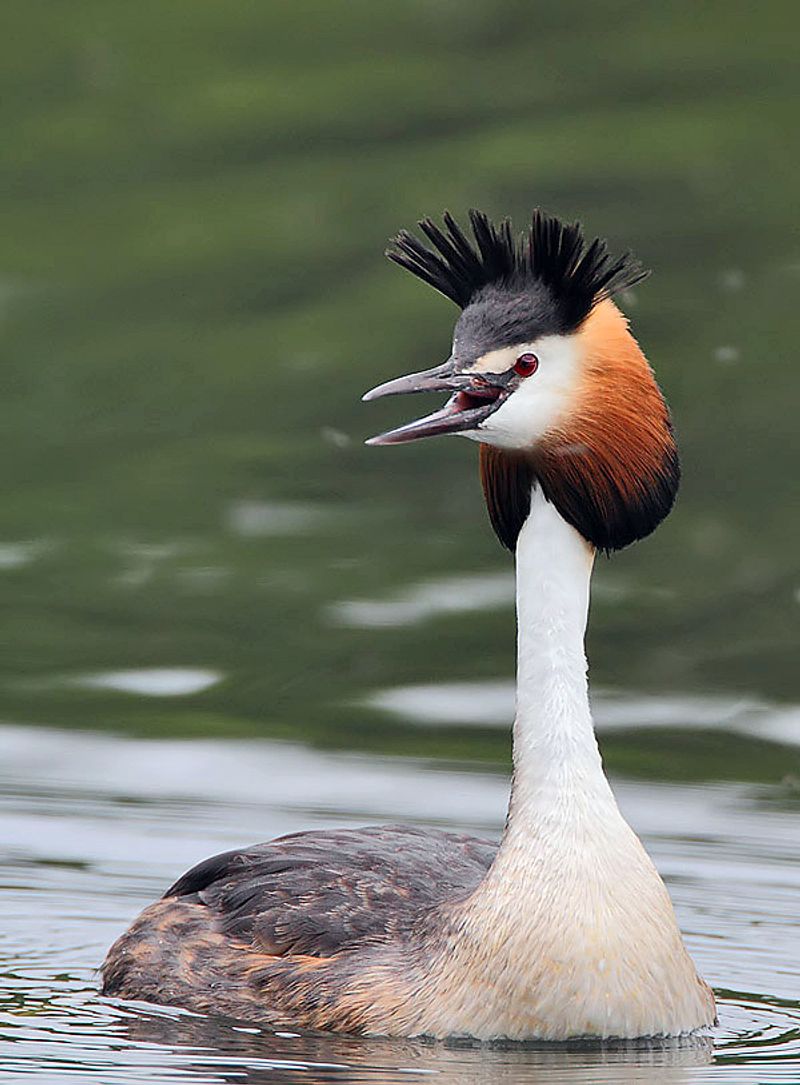
Grebes are a type of bird found throughout the world in both freshwater and marine habitats. These birds, which belong to the order Podicipediformes, are renowned for their ability to dive and swim underwater.
Grebes are generally migratory, with some species inhabiting the marine environment during the winter season. Most grebes are capable of flight, although there are a few species that are flightless, usually those found in stable lakes.
These flightless species are unique in that they have evolved to live in their environment without the need for flying. Grebes are an important part of the aquatic ecosystem, helping to control the population of smaller fish and aquatic invertebrates.
Their presence is essential to the health of many aquatic systems, and they are often studied by researchers to help understand the dynamics of these ecosystems.
| Kingdom | Animalia |
| Phylum | Chordata |
| Class | Aves |
| Clade | Mirandornithes |
| Order | Podicipediformes |
| Family | Podicipedidae |
9. Cattle Egret
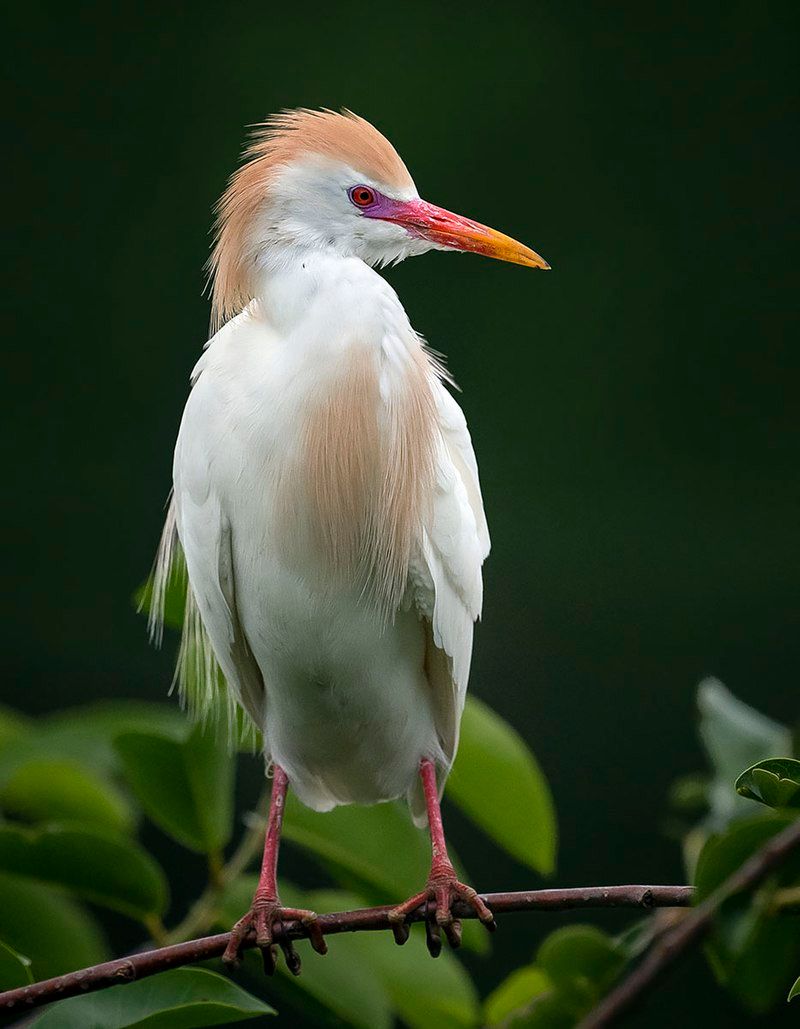
The Cattle Egret is a heron species that is found in a variety of climates, ranging from tropical to warm-temperate climate zones.
It is the only species within its genus, Bubulcus, although some experts believe that it has two distinct subspecies: the Western Cattle Egret and the Eastern Cattle Egret.
This species of heron is widely distributed around the world and can be found in Africa, Asia, Australia, and the Americas. The Cattle Egrets are generally found in grassy habitats, such as pastures, meadows, and marshes, and they feed mainly on insects, small mammals, and amphibians.
They have adapted to a wide variety of habitats and climates, and have a diverse diet.
They are often found in groups, which makes them easy to spot in the wild. The Cattle Egrets have a white or grayish plumage and often have a yellowish or reddish tint to their head and neck feathers. They are usually about 25 cm in length and have a wingspan of up to 80 cm.
They are quite vocal, and their calls are often heard in the evening and early morning. The Cattle Egrets are an important species in many ecosystems, as they help to maintain the balance of the food chain.
They are also of great importance to farmers, as they help to control pests on their farms. They provide important ecosystem services and are a valuable part of the natural environment.
| Kingdom | Animalia |
| Phylum | Chordata |
| Class | Aves |
| Order | Pelecaniformes |
| Family | Ardeidae |
| Genus | Bubulcus |
| Species | B. ibis |
10. European Turtle Dove
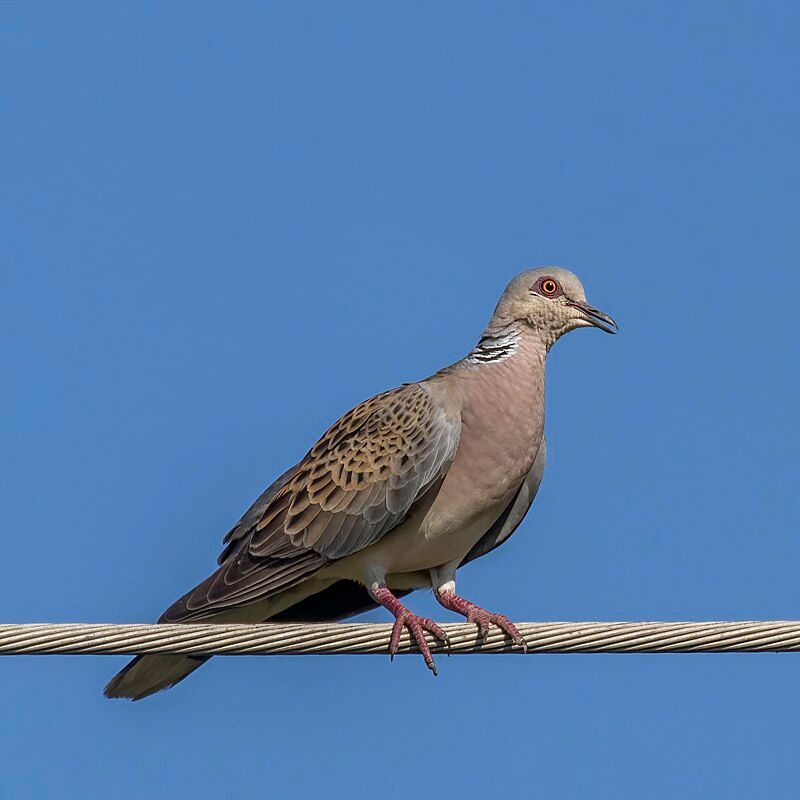
The European turtle dove is a species of bird that belongs to the family Columbidae, which includes doves and pigeons. It is a migratory bird, meaning that it changes its location during the year.
During the breeding season, it can be found in a wide area across the south western Palearctic region, which includes parts of north Africa. During the winter, the European turtle dove migrates further south, to northern sub-Saharan Africa.
This species is well adapted to its migratory lifestyle and has evolved special behavioural patterns and physical adaptations to facilitate a successful migration.
In particular, they fly very high and in large flocks, to take advantage of the winds and reduce energy expenditure.
| Kingdom | Animalia |
| Phylum | Chordata |
| Class | Aves |
| Order | Columbiformes |
| Family | Columbidae |
| Genus | Streptopelia |
| Species | S. turtur |
11. Columbidae
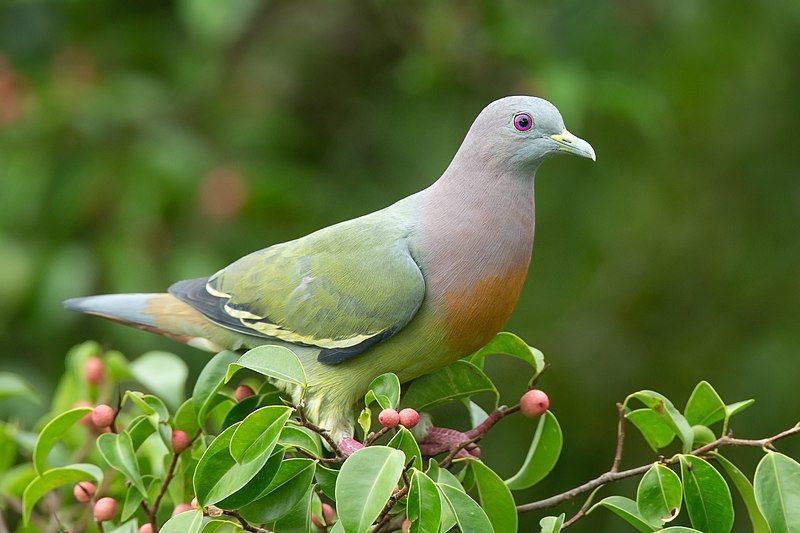
Columbidae is a family of birds that includes the doves and pigeons. This family is the only one in the order Columbiformes. Generally, these birds have short necks, short and slender bills, and their bodies are stout.
In some species, the bills have fleshy ceres, which are small fleshy protuberances near the base of the upper bill. The Columbidae family mainly feeds on seeds, fruits, and plants.
They are incredibly diverse and are found in a variety of habitats, from open woodlands to arid deserts. They are also known to be very adaptable, able to survive in urban areas and even on small islands.
Columbidae birds are popular as pets due to their generally peaceful and gentle nature.
| Kingdom | Animalia |
| Phylum | Chordata |
| Class | Aves |
| Clade | Columbimorphae |
| Order | Columbiformes |
| Family | Columbidae |
12. Common Cuckoo
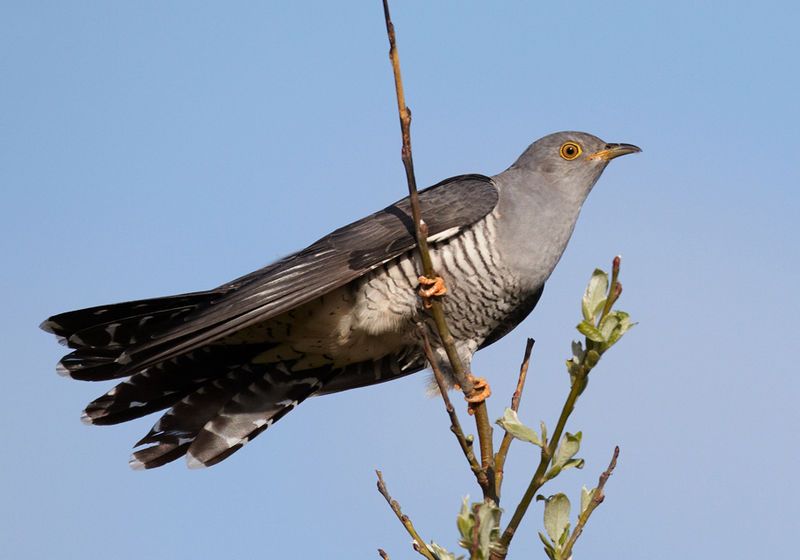
The common cuckoo is a species of bird that belongs to the Cuculiformes order, which is a large group of birds that includes many of the most recognizable species in the avian world.
This order includes the roadrunners, the anis, and the coucals, which are all distinctive in their own way. The common cuckoo is a migratory bird, and its range is quite broad.
During the summer months, they can be seen all across Europe and Asia, where they are often seen in open fields and woodlands. In the winter, however, they migrate south to Africa, where they can be spotted in savannahs and grasslands.
The common cuckoo is an interesting bird, and it plays an important role in its environment. Due to its migratory tendencies, it helps spread the seeds of the plants it eats across vast distances.
This helps to ensure that these plants can thrive in multiple places, increasing the overall biodiversity of the planet. Overall, the common cuckoo is an important species that helps maintain the delicate balance of nature.
It has a wide range and is easily recognizable due to its distinctive appearance. This species is a valuable part of the ecosystem and deserves to be appreciated and respected.
| Kingdom | Animalia |
| Phylum | Chordata |
| Class | Aves |
| Order | Cuculiformes |
| Family | Cuculidae |
| Genus | Cuculus |
| Species | C. canorus |
13. Gadwall
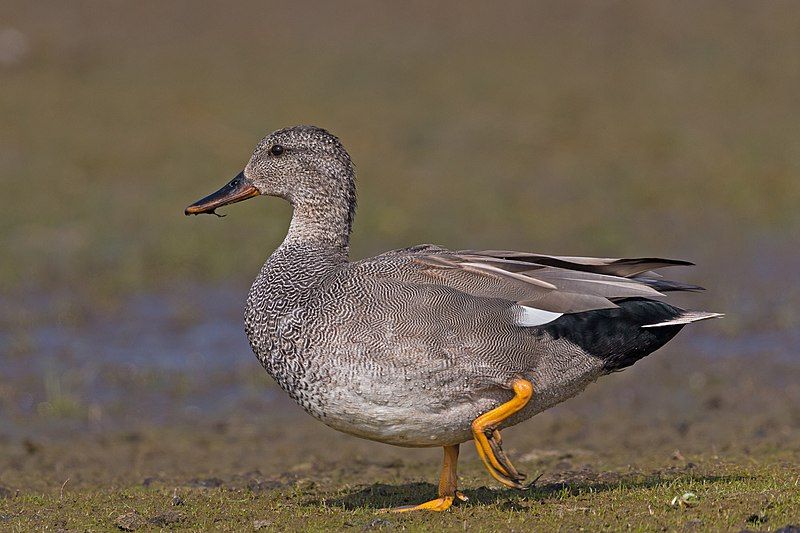
The gadwall is a species of duck belonging to the family Anatidae. It is a common and widespread species, found in wetlands, ponds, rivers, and lakes throughout much of the Northern Hemisphere.
Gadwalls are medium-sized ducks that measure between 17 and 20 inches in length and weigh anywhere from 1 to 2 pounds. They have a mottled brownish-gray plumage that helps them blend in with their natural environment.
They have a white belly and a white patch on their wings that is visible in flight. During the breeding season, males have a blackish head, neck, and upper breast which gives them a distinctive appearance.
Gadwalls are dabbling ducks, which means they feed by tipping their head underwater and scooping up food from the surface of the water. They feed on a variety of aquatic plants and invertebrates such as mollusks, crustaceans, and insects. They also eat some grains and seeds.
Gadwalls usually nest near water, either in a tree, on the ground, or in a hidden spot in tall grass. They typically lay 8-12 eggs in a single clutch and the female will incubate them for about 25 days.
Both parents help to raise their young, which are able to fly within 2 months of hatching. The gadwall is a hardy species that is not endangered or threatened, and it is an important game bird in many parts of the world.
They are also popular with birdwatchers due to their colorful appearance and their readiness to approach humans.
| Kingdom | Animalia |
| Phylum | Chordata |
| Class | Aves |
| Order | Anseriformes |
| Family | Anatidae |
| Genus | Mareca |
| Species | M. strepera |
14. Common Pheasant
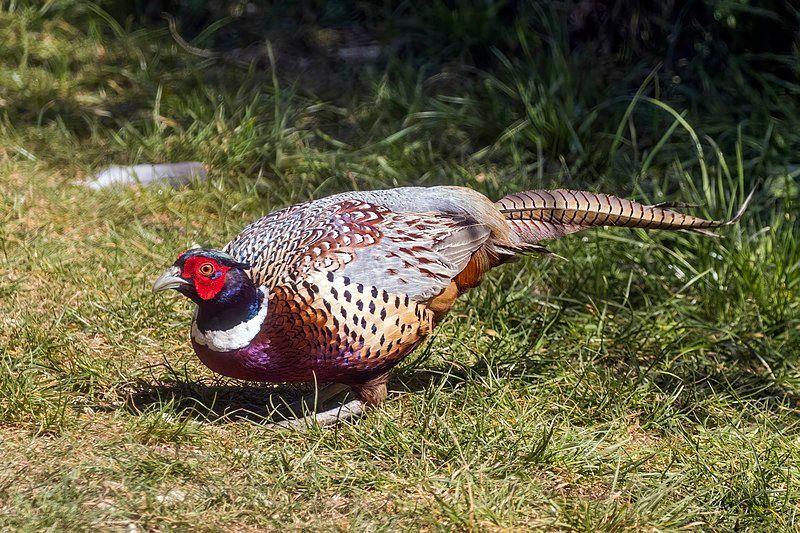
The common pheasant is a member of the pheasant family of birds. Its genus name, phasianus, is derived from the Latin word for pheasant. The species name, colchicus, is Latin for “of Colchis”, a country located on the Black Sea.
Pheasants were most likely first observed by Europeans in Colchis, which is why they were named for that region. Common pheasants have a wide range of habitats, including grassy fields and woodlands. They are a popular game bird and can be found in many parts of the world.
The male pheasant is particularly striking, with its long tail feathers, glossy plumage, and bright colors. The female is usually a mottled brown or gray color. Both sexes have a characteristic long neck and small head.
Common pheasants feed on a variety of plants, insects, and small animals. They also have a unique voice, which is made up of a variety of calls, including crowing, clucking, and purring.
| Kingdom | Animalia |
| Phylum | Chordata |
| Class | Aves |
| Order | Galliformes |
| Family | Phasianidae |
| Genus | Phasianus |
| Species | P. colchicus |
15. Great-Crested Grebe
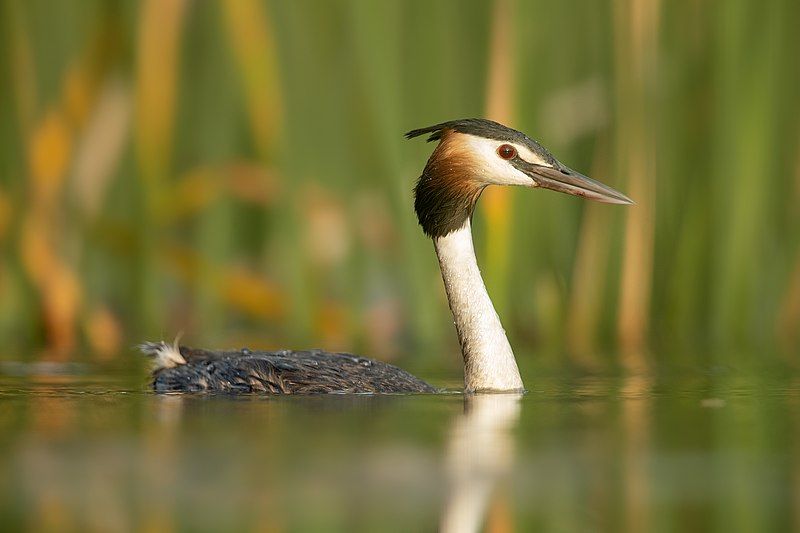
The great crested grebe is a species of aquatic bird in the grebe family. It is found throughout the world in temperate and subarctic regions. This species is particularly noted for its elaborate mating display.
The males and females will both perform a ritualistic dance, which involves them running across the surface of the water, jumping up and down, and diving under the water. This dance is thought to be a way to attract potential mates and show off their plumage.
The males also build a nest of reeds and vegetation, which they use to court their mates. The female will then lay her eggs in the nest and both parents will take turns incubating them.
The great crested grebe has a distinctive appearance, with black and white plumage, a red and black beak, and a red eye. Its feet are webbed and it has a long neck and a short tail. It feeds mainly on small fish, aquatic insects, and crustaceans.
This species is vulnerable to habitat destruction and overfishing, and as such is classified as Near Threatened on the IUCN Red List.
| Kingdom | Animalia |
| Phylum | Chordata |
| Class | Aves |
| Order | Podicipediformes |
| Family | Podicipedidae |
| Genus | Podiceps |
| Species | P. cristatus |
16. Red-Legged Partridge
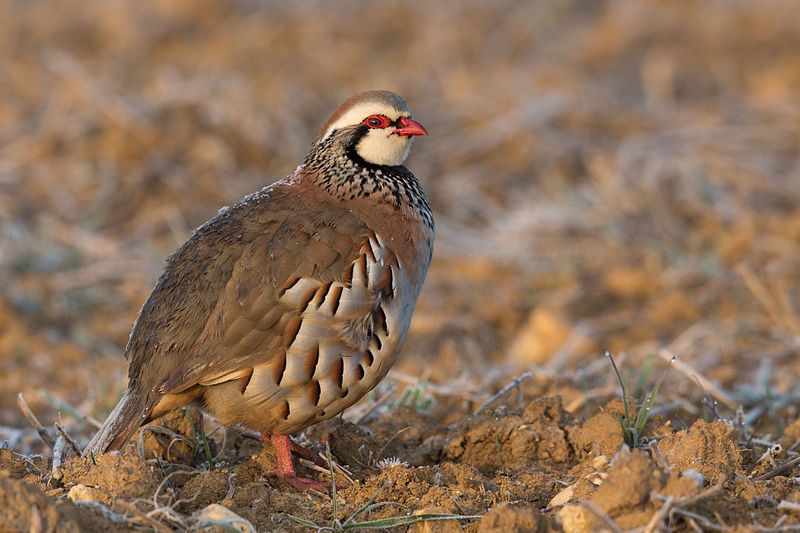
The red-legged partridge is a species of gamebird that belongs to the Phasianidae family, which is part of the order Galliformes. These birds, also known as gallinaceous birds, are found in many regions around the world.
The red-legged partridge is also known as the French partridge, to differentiate it from the English or grey partridge.
This species of bird is often hunted for sport and is considered a game bird. The red-legged partridge has a distinct physical appearance, with its reddish-brown legs and greyish-brown body. The wings are a darker shade of brown and the tail is a darker grey.
The face of the bird is white with a black eye stripe, and the neck and breasts are a darker grey.
The red-legged partridge is known for its vocalizations, which include a loud cackling call as well as a softer purring sound. This species of gamebird prefers open fields and grassy areas for its habitat. It can also be found in wooded areas and on the edges of forests.
The red-legged partridge is omnivorous and feeds on a variety of seeds, fruits, and insects. This species of bird has a long lifespan, with some birds living up to 10 years in the wild. The red-legged partridge is an important species as it is often hunted for sport.
It is also an important part of the food chain, as it provides food for many other species. This species of gamebird also plays an important role in helping to maintain the balance of nature by helping to keep the population of plant-eating insects in check.
| Kingdom | Animalia |
| Phylum | Chordata |
| Class | Aves |
| Order | Galliformes |
| Family | Phasianidae |
| Genus | Alectoris |
| Species | A. rufa |
17. Common Pochard
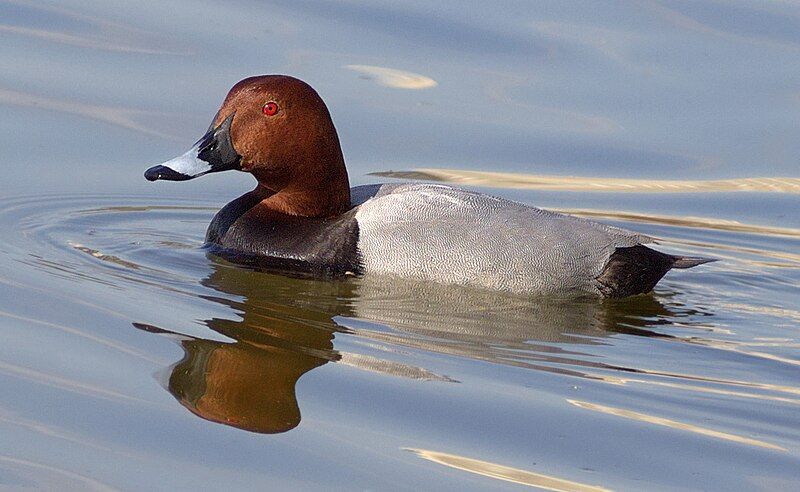
The common pochard is a species of diving duck that is native to many parts of the world. It is a medium-sized bird, usually measuring between 46 and 54 centimeters in length. The scientific name of the species, Aythya ferina, is derived from Greek and Latin words.
The Greek word ‘aithuia’ is an unidentified seabird that has been mentioned by various authors, such as Hesychius and Aristotle. The Latin word ‘ferina’ is derived from the word ‘ferus’, meaning ‘wild’, and translates to “wild game”.
This is a reference to the wild nature of the common pochard. It inhabits habitats such as wetlands, shallow water bodies, and lakes. The species feeds mainly on aquatic plants and insects.
| Kingdom | Animalia |
| Phylum | Chordata |
| Class | Aves |
| Order | Anseriformes |
| Family | Anatidae |
| Genus | Aythya |
| Species | A. ferina |
18. Common Shelduck
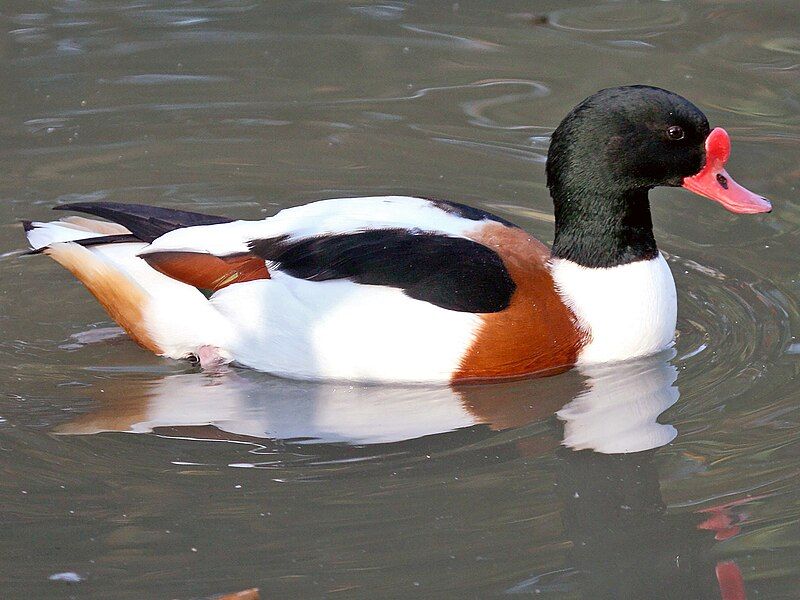
The common shelduck is a species of waterfowl that belongs to the shelduck genus, Tadorna. It is found in a large area that stretches from Europe to northern Asia, known as the Euro-Siberian region of the Palearctic.
This species is quite widespread and common in this region, with its main breeding grounds in temperate areas. During the winter months, it migrates to subtropical regions, such as the Maghreb. Here, it can find more suitable temperatures and food sources.
This seasonal migration is an essential part of the common shelduck’s life cycle, allowing it to survive and thrive in different parts of the world.
| Kingdom | Animalia |
| Phylum | Chordata |
| Class | Aves |
| Order | Anseriformes |
| Family | Anatidae |
| Genus | Tadorna |
| Species | T. tadorna |
19. Cuckoos
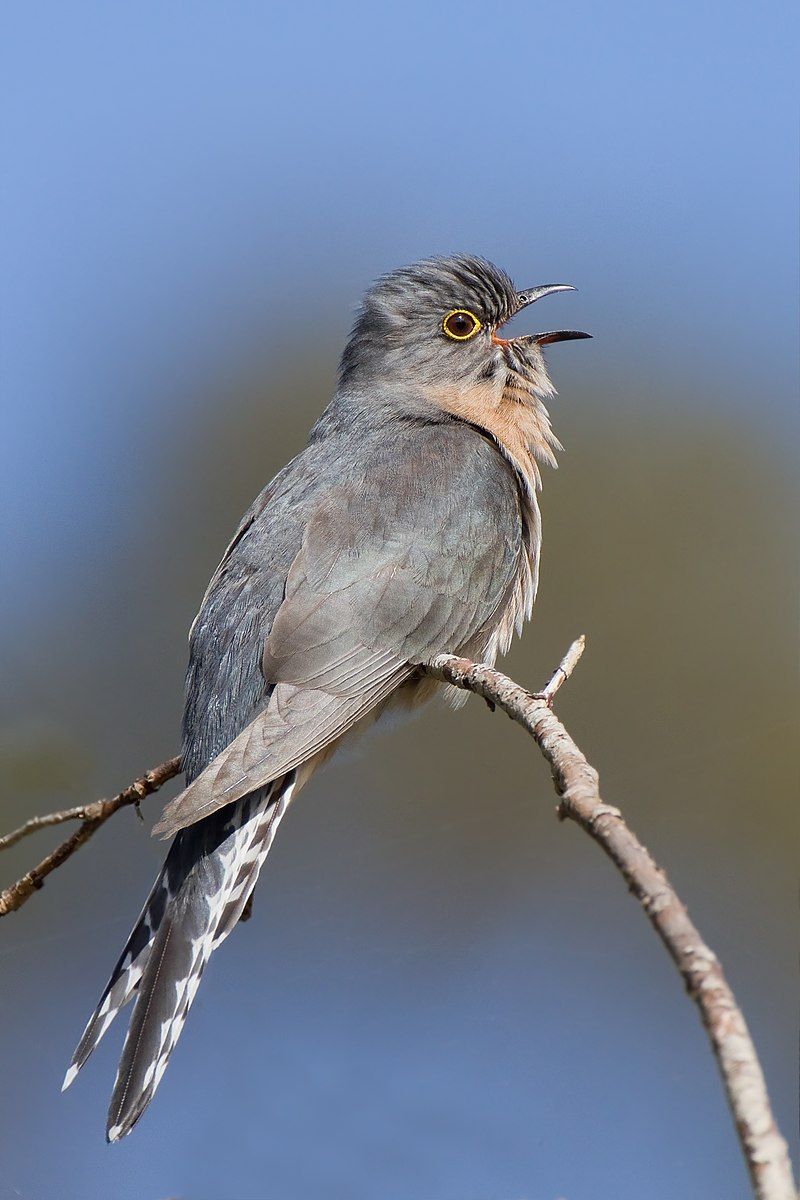
Cuckoos are a diverse group of birds belonging to the family Cuculidae, which is the only group of birds placed in the order Cuculiformes.
The cuckoo family includes the common or European cuckoo, as well as many species found in different regions around the world, such as roadrunners, koels, malkohas, couas, coucals, and anis.
Although all of these birds are typically classified under the Cuculidae family, some experts differentiate between the coucals and the anis, placing them in two distinct families called Centropodidae and Crotophagidae, respectively.
This distinction is based on the particular morphological and behavioral characteristics of each species.
| Kingdom | Animalia |
| Phylum | Chordata |
| Class | Aves |
| Clade | Otidimorphae |
| Order | Cuculiformes |
| Family | Cuculidae |
20. Ruddy Shelduck
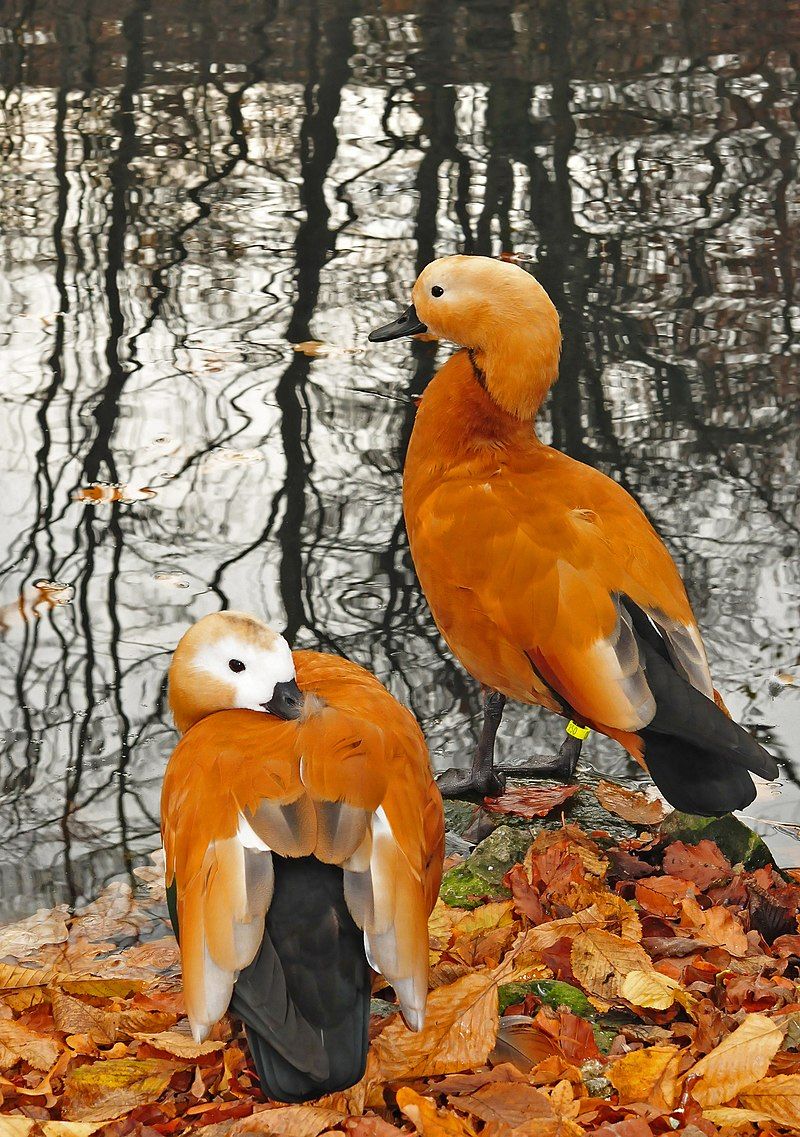
The ruddy shelduck, also known as the Brahminy duck, is a unique waterfowl belonging to the Anatidae family. It is easily recognisable due to its size, ranging from 58 to 70 cm in length and having a wingspan of 110 to 135 cm.
Its plumage is usually a reddish-brown colour, with a paler head and neck, although it can sometimes be seen with a more orange hue. The bill is usually black with a white band around it, whilst the legs and feet are bright orange.
This bird is a strong flier, often seen moving in pairs or small groups, and is a sight to behold when in flight. It is usually found in wetlands and other shallow water bodies, where it feeds on aquatic plants and invertebrates.
The ruddy shelduck has a strong presence in India, particularly in the North and West, and is an iconic species in the region.
| Kingdom | Animalia |
| Phylum | Chordata |
| Class | Aves |
| Order | Anseriformes |
| Family | Anatidae |
| Genus | Tadorna |
| Species | T. ferruginea |
21. Little Grebe
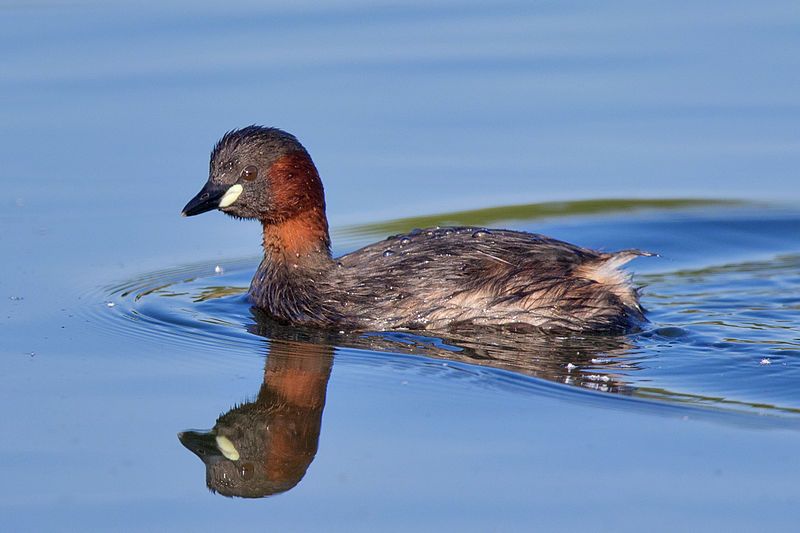
The little grebe, also known as dabchick, is a species of water bird that belongs to the grebe family. Its scientific name, tachybaptus ruficollis, is derived from Ancient Greek and Latin roots.
The genus name, takhus, is derived from Ancient Greek and means “fast”, referring to the bird’s swimming ability. The specific name, ruficollis, is a combination of Latin rufus, meaning “red”, and Modern Latin -collis, meaning “-necked”.
This is because the little grebe has a distinctive redneck. The “-necked” part of the name is derived from the Latin collum, which means “neck”..
| Kingdom | Animalia |
| Phylum | Chordata |
| Class | Aves |
| Order | Podicipediformes |
| Family | Podicipedidae |
| Genus | Tachybaptus |
| Species | T. ruficollis |
22. Eurasian Wigeon
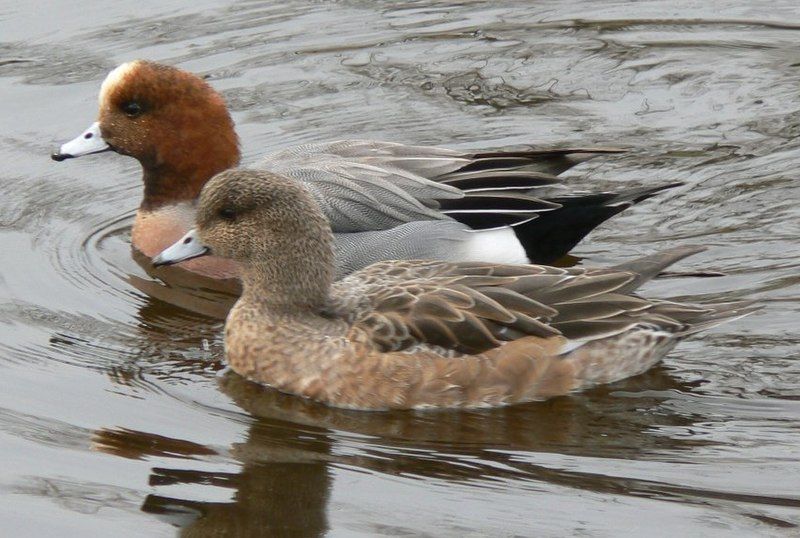
The Eurasian wigeon, also known as the European wigeon, the widgeon, or simply the wigeon, is a species of dabbling duck belonging to the genus Mareca.
It is widely distributed across its Palearctic range, from the British Isles and Scandinavia to Eastern Siberia and Mongolia, and is considered to be a common species.
It has been observed in a variety of habitats, ranging from wetlands and lakes to estuaries and coastal lagoons, and is usually found in large flocks in winter.
The Eurasian wigeon is easily distinguished from its congeners by its white head, chestnut-colored sides, and its white-spotted black back. Its underparts are usually white with a greyish-brown breast, and its bill is pale grey with a black tip.
The Eurasian wigeon is a medium-sized duck, measuring around 40-50 cm in length, with a wingspan of 70-78 cm. It has a short, broad bill, and in flight, its wings produce a distinctive whistling sound.
During the breeding season, it has a distinctive call, which consists of a loud, harsh ‘quack’. Its diet consists mostly of aquatic plants, aquatic invertebrates, and grains. It is also known to feed on insects and crustaceans.
The Eurasian wigeon is a socially gregarious species, and forms large, noisy flocks during the winter months. It breeds in the northern parts of its range, and lays four to seven eggs in a nest made from down and dry vegetation.
The chicks are precocial and are able to swim and feed themselves soon after hatching. The Eurasian wigeon is a popular game bird and is hunted extensively in some parts of its range.
| Kingdom | Animalia |
| Phylum | Chordata |
| Class | Aves |
| Order | Anseriformes |
| Family | Anatidae |
| Genus | Mareca |
| Species | M. penelope |
23. Tufted Duck
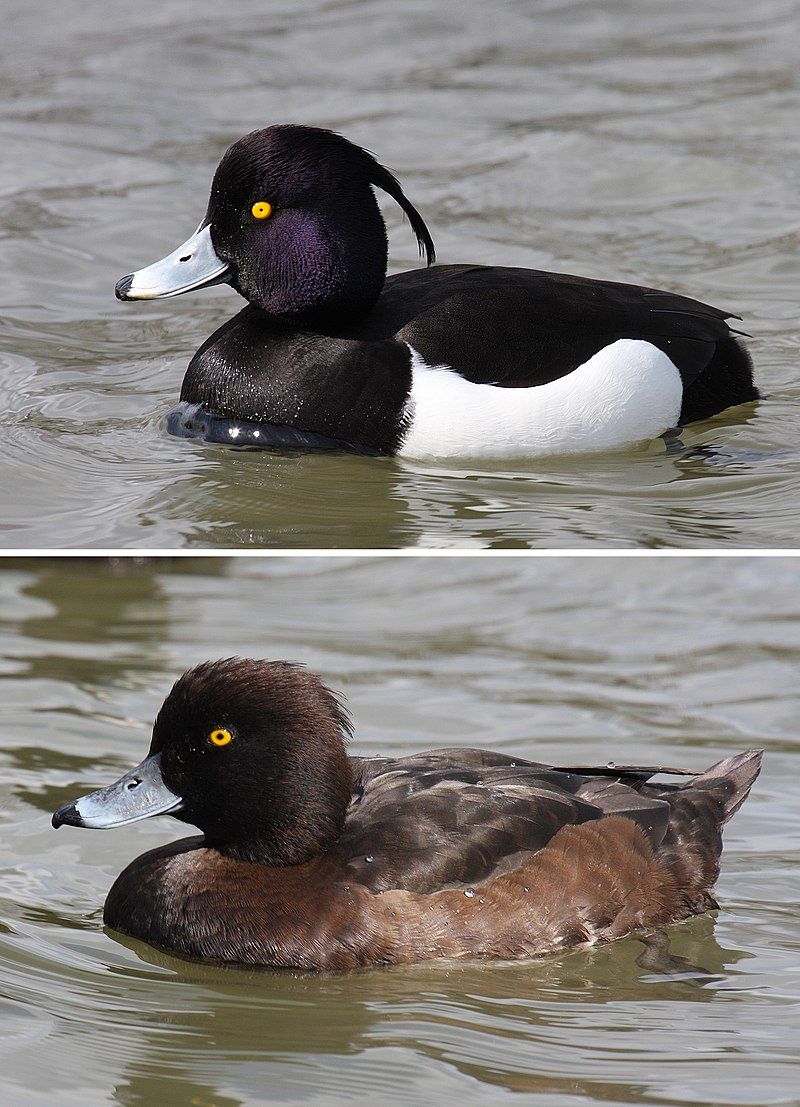
The tufted duck, also known as the tufted pochard, is a small species of diving duck native to northern Eurasia. It is estimated that the population of this species is close to one million birds.
The scientific name of the tufted duck is derived from two sources: the Ancient Greek aithuia, which was an unidentified seabird mentioned by authors such as Hesychius and Aristotle, and the Latin words fuligo (“soot”) and gula (“throat”).
This name is likely a reference to the distinctive black and white plumage of the tufted duck, which is characterized by a white breast and dark head and neck. The tufted duck has a long, pointed bill and a crest of feathers on the back of its head.
It is an excellent swimmer and diver, and feeds on aquatic vegetation, insects, and mollusks. The tufted duck breeds in wetlands, ponds, and shallow lakes, and is a migratory species, wintering in southern Europe and North Africa.
| Kingdom | Animalia |
| Phylum | Chordata |
| Class | Aves |
| Order | Anseriformes |
| Family | Anatidae |
| Genus | Aythya |
| Species | A. fuligula |
24. Grey Partridge
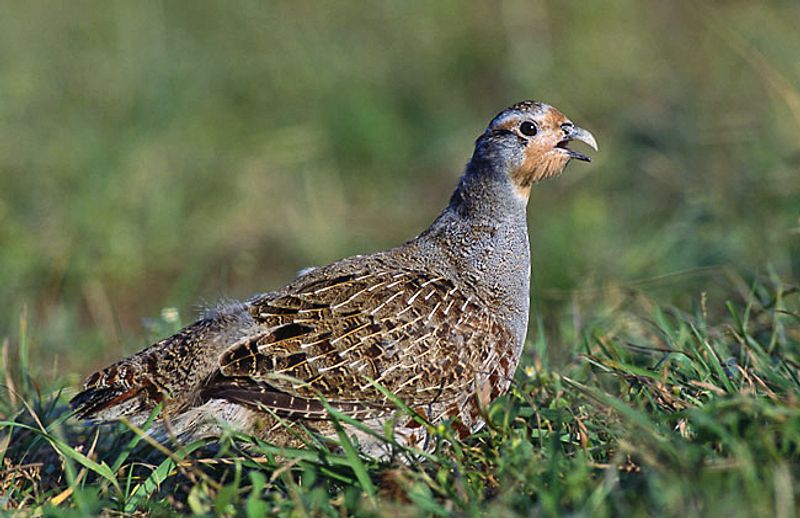
The grey partridge is a type of gamebird in the pheasant family Phasianidae of the order Galliformes, commonly referred to as gallinaceous birds. It is a widely distributed species, also known as the gray-legged partridge, English partridge, Hungarian partridge, or hun.
Its scientific name, perdix, is derived from Ancient Greek and is the Latin for “partridge”. The grey partridge is a medium-sized bird, usually found in pairs or small groups. It is a seed-eater, foraging in grassy areas for seeds, insects, and other small invertebrates.
It has a brownish-grey upper body, blackish-brown face and neck, and white-spotted breast. The grey partridge is an important game bird in many parts of the world and is hunted for sport and food.
| Kingdom | Animalia |
| Phylum | Chordata |
| Class | Aves |
| Order | Galliformes |
| Family | Phasianidae |
| Genus | Perdix |
| Species | P. perdix |
Conclusion
The birds of Aquitaine are a diverse and beautiful species that are integral to the region’s ecology.
They offer an array of colors, sizes, and behaviors, making them a delightful addition to any nature enthusiast’s experience.
While the birds of Aquitaine face a number of threats, through conservation and awareness, they will continue to be a vital part of the region’s ecosystem.